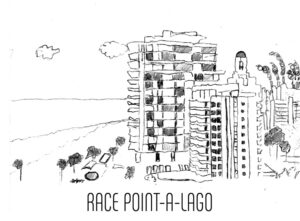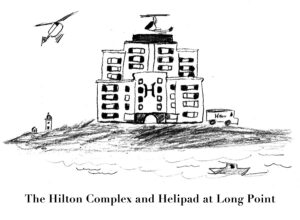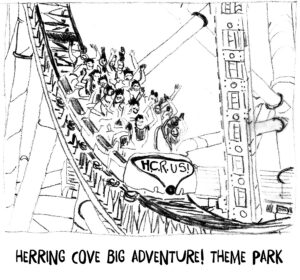Saturday, August 8, 1970
Just got into town yesterday, after quite a few years away. What a lot of exciting changes! Instead of taking boring Route 6, I took the new causeway from Plymouth across Cape Cod Bay — a really cool drive over the water — and stopped at the newly created midway island, where I visited the casino for about an hour and lost a few bucks.
Approaching Provincetown Harbor, the first thing I saw was the brand-new helipad next to Long Point Light, with choppers coming and going, and the majestic Long Point Hilton complex built on the site of the old Civil War fortifications nearby. The hotel faces the ultra-modern West End Marina, built where I remember the old West End Marsh and tidal flats. I suppose I’ll miss clamming there, but what an amazing array of luxury yachts and power boats! I hear the marina lounge, the Stuffed Quahog, is the hot spot in town for the boating set: nothing like it outside Nantucket, they say.
I didn’t go into town right away because I wanted to see what they’ve done out at New Beach. I drove out there on the new six-lane highway that used to be Route 6, pulling into the Villages at Clapps Pond on the way. Wow. What they created on that old shrubby pond!
What I saw first was the shopping mall: it has all the newest stores and rivals anything in Hyannis. Beyond it is the new golf course with an elegant clubhouse. I am told that the course is famous for its many water hazards — probably the remnants of the pond. I counted five motels with plenty of space on an enormous parking lot. Some of these motels face the highway, and some look out on the enormous swimming and boating area created with a bit of wetland dredging. There is also an Olympic-size swimming pool with its own bathhouse and concession area for those who are a bit squeamish about being in nature. All of this is the setting for over 200 new houses, some really mammoth, set amid what were the sand dunes and woodlands.
What changes! Alongside the New Beach Hilton there was yet another marina, another golf course, an amusement park, a boardwalk, and loads of hamburger and cotton-candy stands.
After all that, going into Old Provincetown was a bit of a letdown. With its quaint shops and restaurants, its historic buildings and art galleries, it’s very nice, as far as it goes. But the New Provincetown beats anything I have seen in New Jersey or Florida. In fact, you can almost imagine that’s where you are!
* * *
None of that occurred: it’s pure fiction. But it’s based on actual proposals. In 1961, the Cape Cod National Seashore was created, and in 1962 the Province Lands, more than 3,000 acres of sand dunes and pine forests, were transferred to the new national park, safe from incursions.
How did that happen?
Many people on the Outer Cape favored the scenario described above. All of those developments — causeways and big hotels, golf courses and mall shopping — were mentioned and even championed. Some argued for private property rights and the merits of future expansion; some resisted “Big Government” and insisted that local zoning could control overbuilding. Then, as now, there were those who favored short-term profit over long-term conservation.
But a determined group of farsighted citizens fought tirelessly on behalf of the new national park as a way to combat the tide of unrestrained development. Of these, none was more stalwart than the late Josephine Breen Del Deo. Alongside her in this effort was the artist Ross Moffett. While he was wise and tactical, he was not a public speaker. Josephine was the movement’s main spokesperson.
Their group lobbied for almost three years. They wrote hundreds if not thousands of letters, made as many phone calls, and attended numerous meetings and hearings in Eastham, Boston, and Washington, D.C. Josephine described this process in her book The Watch at Peaked Hill (Schiffer, 2015) as “countless hours and … personal anguish” to forestall the looming threat.
“My mother knocked on every door in the West End,” said her son, Romolo Del Deo. Finally, at a town meeting on March 13, 1961, at about 11 p.m., the vote was cast: 144 to 61. Provincetown was the only town on the Cape that endorsed the park unconditionally.
If you have ever gone swimming at Herring Cove or walked the beach at Race Point or stayed in a dune shack or hiked around Clapps Pond or the Beech Forest or gone clamming on the West End flats, you had Josephine Del Deo with you, and you have her to thank for the experience.
There is more. The Fine Arts Work Center started “right here,” says Sal Del Deo, gesturing to his living room. Josephine and husband Sal were part of a small group of founders of that essential organization in 1968. It originally operated out of the Provincetown Art Association and included only artists. “Stay away from the writers,” said Josephine, a noted writer herself, though she eventually relented. The first class included Arthur Cohen and Joan Perreira.
In 1976, when the old Methodist Church, which is now our library, was considered “a white elephant” and threatened with private development and even demolition, Josephine persuaded town voters — “with a hell of a lot of oratory,” says Sal — to take over the building. She became a cofounder of the Heritage Museum there.
Late in the 1960s, Josephine became president of the Provincetown Symphony Society. In the same period, she cofounded the Provincetown Food Coop. She also initiated the first American Civil Liberties Union chapter in town, bringing national issues including racial justice, free speech, nuclear disarmament, and resistance to war to a local level. She attempted, in vain, to get the entire town included in a historic district — “her one defeat,” says Sal.
If you care about Provincetown as a center for the arts and literature, if you feel history as you walk our streets, if you enjoy our wonderful library, if you appreciate the fact that this town stands as a beacon for liberal causes, you have Josephine by your side, and you have her to thank.
“Almost every year she had a cause,” Sal says. “She was more than just a pretty face — she was tough, she was a power. She loved this town.”
And Josephine and Sal were a team: “Everything we did, we did together,” he says. “We committed ourselves to this town.”
Some say the only real and lasting good you do in life you do by example. If that is true, look to the record of this remarkable woman and her husband, beginning his 96th year this month. Realize what love and commitment can accomplish. And get to work.



